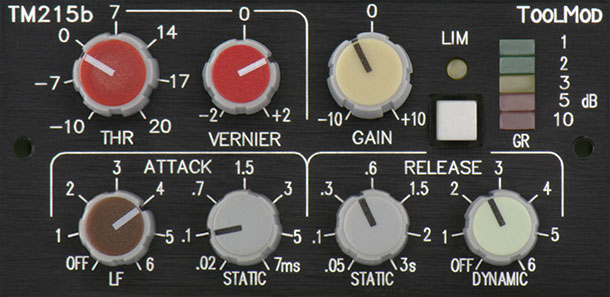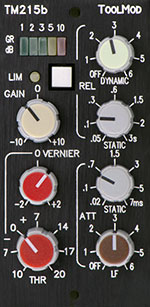

 ToolMod Pro Audio ToolMod Pro AudioStereo Mastering Peak Limiter TM215b Extremely fast Peak Limiter with additional Features for Stereo Mastering The TM215b is a Stereo Mastering Peak Limiter with precise stereo tracking that can catch short peaks without audible side effects. The module operates without colorization and will not alter the sound under regulation. It is fast enough to react within the first period of a 20 kHz sine wave signal. Additional features allow better handling of the physical limitations with fast attack and release times. The TM215b is usually used directly at the end of an analog mastering chain. The output level can be adjusted without affecting the limiter setting. |
Highlights:
all Dynamics:
Dynamics Overview
Mono Modules:
TM112bVCA Compressor TM112 Compressor TM115b Peak Limiter TM115 Brickwall Limiter TM116 Noise-Gate Stereo Modules:
TM212bStereo VCA Compressor TM212 Stereo Compressor TM215b Stereo Mastering Limiter TM215 Stereo Limiter TM132 M/S Mastering Compressor TM222 Stereo Mastering Compressor |
|||||||||||||||||
 Stereo Mastering Peak Limiter TM215b
Stereo Mastering Peak Limiter TM215b
|
||||||||||||||||||
|
The Basics The Stereo Mastering Peak Limiter TM215b has been optimized for the use as output limiter of an analog stereo mastering processing chain. The attack time of this feedforward VCA limiter that uses a special peak detector circuitry is extremely fast and reacts within the first period of a 20 kHz sine wave. This quality is the most important qualification of a limiter that drives the A/D converter at the end of a mastering chain. In combination with a compressor that is optimized for high loudness gain, which requires a long attack time, the limiter takes care of an effective control of the signal peaks that will pass the compressor without causing any regulation. This setup is necessary to increase the A/D converter input level as close as possible to 0 dBFs without overload. The TM215b stereo limiter does not alter the sound below and above threshold. Peak regulation of 3 to 6 dB will not cause audible side effects with an appropriate setting of the parameters under consideration of the physical limitations of any analog limiter but increase the loudness by suppression of the peaks. Possible Gain Reduction and physical Limitations
The maximum gain reduction of the stereo limiter
is way more than 20 dB; however, the feasible gain reduction is a lot lower and
limited by the physical limitations of analog limiters. These are low frequency
distortion with short release times and attack distortion in the bass range with fast attack times.
Low Frequency Distortion with short Release Times
When optimizing the release time
in a way that pumping barely disapears, low
frequency distortion due to regulation within the cycle duration of the audio
signal is one of the issues that determines the maximum gain reduction. Depending
on the portion of low frequency components at high levels in the output signal,
a gain reduction of 3 to 6 dB is realistic und possible without negative side
effects.
Dynamic Release
The dynamic release control, which is actually a variable version of the well
known Auto-Release feature of some compressors, which is adapted to the special
operation parameters of a limiter, is useful for preventing lf-distortion. Dynamic
release increases the release time with high density signals which are in most
cases equivalent to high levels in the bass range. By careful adjustment it is
possible to find a better compromize between audible pumping and lf distortion
than by using the static release control alone.
Static Release
In order to allow precise optimization of the Release Time, the control range is extended down to a value far below the optimum value of approximately 0.3 sec for pump free operation. Although a release time setting of less than 0.3 sec is not possible with low frequency signals, the range below can be used with audio signals with no considerable low frequency components. Such short release times increase the density of the audio signal. The minimum release time is 50 ms; the longest release time is 3 sec. A long release time will cause pumping but offers the choice to adjust a wide range of conventional settings, as they are used with broadcasting.
Attack Distortion
Attack distortion is the second important physical limitation. Due to the necessary
very fast attack that is necessary to prevent overloading the a/d converter inputs,
the limiter warps the wave form of a low frequency signal as soon as the level
exceeds the threshold. The effect disappears with an attack time of about 1 ms;
however, 1 ms is way too long to prevent short peaks from overloading the a/d
converter. Even though the distortion only shows up during the first peak, it
can be audible if the spectrum of the lf signal does not contain a wide
range of harmonics. Unfortunately, there is no perfect way to avoid this effect
but to reduce the gain reduction. The TM215b comes with a special LF-Attack circuit that allows better handling of this problem.
LF Attack
The TM215b comes with a LF attack control that works like some kind of low
frequency soft knee function. Unlike the well known soft knee, lf attack affects
the wave form of the bass signal when the limiter kicks in. The pot determines
the frequency where the smoothing takes place. This means that a higher setting
is not necessarily the better choice. If attack distortion appears, just find
the best setting for the particular problem
Static Attack Time
Only the shortest possible attack time of
20 µs is important when using the TM215b as peak limiter with signals that
contain very short peaks in the upper mid and high frequency range. With this setting, the limiter reacts within 8 Ás from the time when the momentary value exceeds the threshold and the regulation takes place. Since negative time is not possible, this delay will cause the first half wave of a 20 kHz sine wave signal to pass thru without full gain reduction while the second half wave is regulated down to the threshold level. Longer attack times will cause short peaks to pass thru the limiter. However, a longer attack time reduces the attack distortion problem. Therefore the best attack time setting depends
on the occurence of short peaks in the upper mid and high frequency range. Choosing the longest attack time that still catches high frequency peaks ist always the best choice. The attack time control
range reaches up to 7 ms to offer the choice of using the TM215b for other applications
than stereo mastering as well. A longer attack time is well suited to use the
device as additional, hard compressor that can add some density above a threshold
level.
Threshold
The Threshold can be adjusted in the
range from -10 dB to + 20 dB. The 0 dB position is internally calibrated. The
additional Vernier pot serves as fine control for the threshold with a range of +/- 2 dB.
Gain
The Output Gain Control with +/-
10 dB range and precisely calibrated 0 dB position at the center detent affects
only the output level but not the settings of the limiter. After adjusting the
limiter, the gain control is used to adapt the output level to the A/D converter
connected downstream of the limiter.
Gain Reduction Display
Gain Reduction Display is a LED bar graph with 5 LEDs and 10 dB display range.
|
|
|||||||||||||||||
|
Callback Service |
|
| Newsletter |
| Where to buy | |||
| Support | |||
| Download | |||
| Tell A Friend | |||
Imprint
|
The TM222 Stereo Mastering Compressor is the best possible supplement to the TM215 Stereo Limiter. The combination of both devices forms a very effective dynamics processing tool for mastering.
TM 215b Information:
ToolMod Pages
Modules by Type
ToolMod Modules
TM101
transformer Mic Pre TM102
discrete Mic Pre TM103
active DI Amp TM105
5-Band Equalizer TM107
3-Band Equalizer TM112
Compressor TM112b
VCA Compressor TM115
Brickwall Limiter TM115b
Peak Limiter TM116
Noise Gate TM130
M/S Direction Mixer TM131
L/R-M/S Matrix TM132
M/S Compressor TM133
M/S Mastering EQ TM134
4-Band M/S EQ TM204
4-Band Mastering EQ TM205
5-Band Stereo EQ TM212
Stereo Compressor TM212b
Stereo VCA Compressor TM215
Stereo Limiter TM215b
Mastering Limiter TM222
Mastering Compressor
transformer Mic Pre TM102
discrete Mic Pre TM103
active DI Amp TM105
5-Band Equalizer TM107
3-Band Equalizer TM112
Compressor TM112b
VCA Compressor TM115
Brickwall Limiter TM115b
Peak Limiter TM116
Noise Gate TM130
M/S Direction Mixer TM131
L/R-M/S Matrix TM132
M/S Compressor TM133
M/S Mastering EQ TM134
4-Band M/S EQ TM204
4-Band Mastering EQ TM205
5-Band Stereo EQ TM212
Stereo Compressor TM212b
Stereo VCA Compressor TM215
Stereo Limiter TM215b
Mastering Limiter TM222
Mastering Compressor
ToolMod Frames
ToolMod Sets
Prices
Photo Galleries
horizontal Modules:
Gallery Modules 1
Gallery Modules 2
Gallery Modules 3
vertical Modules:
Gallery Modules 1
Gallery Modules 2
Gallery Modules 3
Frames, Sets, Accessories:
Gallery Frames 1
Gallery Frames 2
Gallery Frames 3
Gallery Accessories
ToolMod Sitemap
ToolMod Sitemap
